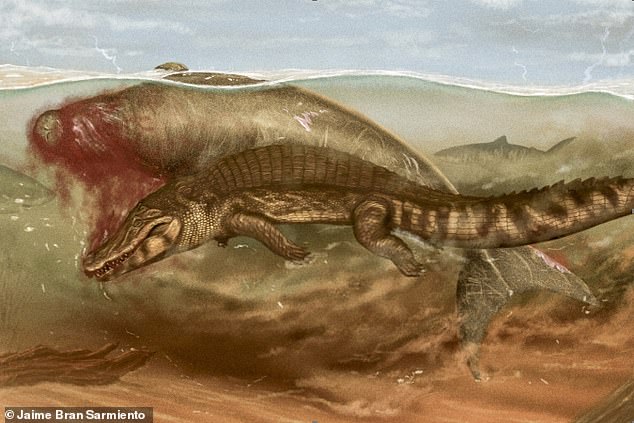From simple fossil fragments, scientists have identified a remarkable underwater battle, frozen in time for millions of years.
An unfortunate sea cow, a mammal that looks a bit like a seal, was torn apart by a crocodile in waters off present-day Venezuela, they say.
When the crocodile finished with the carcass, what was left of the poor animal was devoured by a tiger shark.
The bloody episode that occurred 11.6 million years ago is detailed in a study carried out by paleontologists who have interpreted revealing bite marks on the skeleton of the sea cow.
An incredible art print shows the sea cow dripping blood as it dies, with the shark lurking in the background.
In this artist’s depiction, the sea cow (top) is held by a crocodile underwater about 11.6 million years ago. Crocodiles today look very similar to those from the Jurassic period, 200 million years ago.

Pictured here is a tooth impact mark on the sea cow’s snout. The slimy attack began when the crocodile tried to grab its prey by the snout in an attempt to suffocate it.
“These findings constitute one of the few records documenting multiple predators on a single prey,” says the team, led by experts from the University of Zurich in Switzerland and the Natural History Museum of Los Angeles.
‘Evidence of trophic (feeding) interactions is not scarce in the fossil record, although it is mostly represented by fragmentary fossils that exhibit marks of ambiguous meaning.’
The sea cow skeleton, consisting of a partial skull and 18 vertebrae, was found in the Agua Clara Formation in northwestern Venezuela.
Scientists say it was a dugong sea cow, belonging to the extinct genus Culebratherium, which lived during the early and middle Miocene (23 to 11.6 million years ago).
The fatty sea cow could not fully submerge itself in water, but tended to float on the surface, grazing on algae and making grunting sounds.
This made it particularly vulnerable to hunting by fierce species that lurk in the depths of the water.

The sea cow skeleton, consisting of a partial skull and 18 vertebrae, was found in what is now northwestern Venezuela.

Pictured here is a shark bite mark. The findings mark one of the few examples of a creature being attacked by multiple animals.

The team’s discovery was made in outcrops of the Agua Clara Formation from the Early to Middle Miocene, south of the city of Coro, Venezuela.
According to researchers, deep tooth marks on the sea cow’s snout suggest the crocodile first attempted to grab its prey by the snout in an attempt to suffocate it.
Two other large incisions indicate that the crocodile then dragged the sea cow away, tearing its flesh in the process and turning the water a deep red with blood.
The cunning crocodile then likely performed a “death roll” while grabbing its prey, a behavior commonly observed in modern crocodiles.
A tiger shark tooth found in the sea cow’s neck and shark bite marks seen across the skeleton show the creature’s remains were later torn apart by scavengers.
“Due to the uneven distribution of shark bite marks, these are interpreted as scavenging,” the authors say.

Pictured here is a dugong (a modern relative of the extinct sea cow in question) grazing in shallow water near Marsa Alam, Egypt, Red Sea.
The findings mark one of the only examples of a creature that was attacked by two different predators during the Early and Middle Miocene epoch, the team says.
They also add to evidence suggesting that the food chain, millions of years ago, behaved in a similar way to today.
“Nowadays, often when we observe a predator in the wild, we find the carcass of a prey that also demonstrates its function as a food source for other animals,” said lead author Aldo Benites-Palomino of the University of Zurich.
‘But fossil records of this are rarer, so we haven’t been sure which animals would serve this purpose as a food source for multiple predators.
‘Our previous research has identified sperm whales scavenging several shark species, and this new research highlights the importance of sea cows within the food chain.’
The new study has been published in the journal Journal of vertebrate paleontology.


